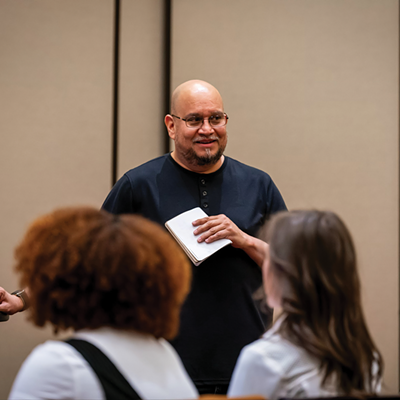It's quite the laundry list--but lawmakers aren't making whites whiter and colors brighter this year, thanks to a shortfall of somewhere close to a billion bucks in a $7 billion budget. Even worse, they've already used most of their ancient Chinese secrets to clean a $670 million shortfall in a special session last fall. (See "The Budget," below.)
The Body
The Arizona Legislature convenes in January of each year for what lawmakers hope will be a 100-day session.
State lawmakers come from 30 districts, home to two representatives and one senator each. That means when it comes to passing legislation, the magic numbers are 16 in the Senate and 31 in the House of Representatives.
Thanks to an all-too-infrequent moment of political justice (see "Strikers," below), the state Senate is currently split 15-15 Democrats and Republicans, while the state House of Representatives is 36-24, Republicans in the majority. As a result, the House is under firm Republican control, while the Senate has seen a rare emergence of Democratic influence following the ascension of Sen. Randall Gnant. The Scottsdale Republican irked members of his own caucus when he quickly made book with Democrats after the November 2000 elections to get himself elected Senate President, thereby birthing the mutant oddity known as the "Kumbaya Legislature."
Unfortunately for the moderates, their rise coincided with a tanking economy, leaving them to a rude awakening from all those dreams of expanded health care, smaller classrooms, bigger highways and better pay for state employees.
The Kumbaya Legislature has less than a year to live. Term limits and political ambitions will clear out many experienced lawmakers, but the biggest change will be driven by redistricting. As required following the U.S. census, the state scrambled its political boundaries last year, giving Republicans even more of an advantage than they've had over the last decade, when they dominated Arizona politics.
The process was overseen for the first time by the Independent Redistricting Committee, a five-member panel that met across the state, studied maps, heard citizen testimony and got pressured by backroom players as it sliced and diced the lines. The new process was created by a 2000 voter initiative mostly funded by Maricopa County shopping-center developer Jim Pederson, who spent more than $600,000 to convince voters that stripping lawmakers of the power to draw districts would create more balanced and competitive districts.
While the political needs of incumbents were no longer at the top of the priority list, the new districts remain politically lopsided. Although Pederson touts a map that drew more equitable districts, the committee says its end design is an inevitable result when you're also considering communities of interest, as required by federal law--unless you're empowered to bus Democrats into Republican neighborhoods and vice versa for a more equitable political distribution of voters. In the end, Republicans hold a solid advantage in 17 of the state's 30 districts, with some GOP strategists predicting the party will capture 19 Senate seats in November.
Bad news for Pederson, now state chairman of the Democratic Party, whose high hopes of making headway in the Legislature have degenerated into hoping he won't have his Democratic ass served up and handed to him. One option is open to the party chief: He could sue the state over the results of the process he put into place. With the new maps now under review by the U.S. Justice Department, any legal challenges are just around the corner.
How a Bill Becomes a Law
Perched atop the copper dome of the Arizona State Capitol, the statue of Winged Victory keeps her eye on the collection of scoundrels we call legislators. Ostensibly, they are the only ones graced with the power to introduce legislation. Can't you just see them, lying back on picnic blankets in the Wesley Bolin Plaza next to the Capitol, arms comfortably folded behind their heads, casting their eyes brightly to the skies above and dreaming up the bills of tomorrow?
Well, when former Rep. Jeff Groscost did that, he decided to legalize ranching Gila monsters. Rep. Debra Brimhall, possibly while watching a rerun episode of Xena, suddenly came face to face with the reality that term limits would send her packing soon and came up with the idea to term-limit journalists, lobbyists and bureaucrats. If she was going back to a trailer park in Pinedale after eight years, by God, somebody was going down with her.
That's the danger of letting them think for themselves. Brimhall calls a little bureaucrat with a green eyeshade we'll call "Sparky." Sparky and others like him are the faceless souls who work in the bowels of the Legislative Council. He opens up a bill file for Brimhall and translates her artful musings into legalese.
Once in a while, you the voter/constituent can get a crack at thinking up your own legislation. Sometimes you want to strengthen date-rape drug laws or fund a program that, if it just got enough money, would allow the skies to open up, sunshine to pour down from heaven, birds and bees to frolic in meadows with children and world peace to be achieved. Other times you call up Bill McGibbon and say, "Sir, before y'all give a death-row killer the needle, why not harvest his organs?" And to your surprise, Wild Bill says yes and a bill is born. Once again Sparky back over at Leg Council is called and the language is drafted.
At least a third of the time, however, those in the power structure, say wheel-dealer Jim Click or legendary land speculator Don Diamond, call up their favorite legislator. Maybe you want to give tax credits for owning alt-fuel vehicles, perchance. You have a lobbyist like Michael Williams or John Mangum give Jeff Groscost a call. You don't even need Sparky. You get your own $500-an-hour lawyers to draft the thing and you're in business.
That's the sausage-making process of dreaming up the bills. To actually get them passed, the sponsor can't be hated by the Speaker of the House or the President of the Senate. Back in the old days, that meant Democrats were screwed. Their introduction of bills was largely a masturbatory affair because nobody let them go anywhere. Now, however, with the Senate split 15-15, President Gnant lets all the bills get heard at least in the Senate.
Committees
Once a bill is introduced, it is assigned to the appropriate committee. If your bill has to do with, say, the regulation of anal probes, it would go to the Health Committee. Let's hope you haven't pissed off Sen. Sue Gerard lately, because she chairs the Health Committee and she just may shove your bill into her bottom drawer to gather dust for the next 90 days.
The committee system turns the individual committee chairmen into princes, with the Rules Committee in a particularly powerful position. Ostensibly created to ensure every bill is reviewed for its constitutionality (so long to your journalist term-limits, Brimhall), throughout the '90s it was the place to kneecap politicians for not toeing the majority leadership's line.
Television coverage of Washington hearings may have left you with an idealized version of committee hearings: Bobby Kennedy squaring off against a squirming Jimmy Hoffa, for example, or Clarence Thomas complaining before the klieg lights of television cameras that he's undergoing the "high-tech lynching of an uppity black man."
A legislative committee meeting is more like sixth-period study hall at Rincon High on a Friday when everybody wants to get their freak on in the Jack-in-the-Box parking lot. While staff members, lobbyists and constituents testify, lawmakers fidget, play solitaire on their laptops and occasionally even get up from their seats and wander off. Don't worry--they'll slide back in if their votes are needed. Meanwhile, pages in blue blazers slip back and forth bringing the lawmakers Cokes and handing them little messages from other lawmakers: Do you think Sen. Bungard is a hottie? Check One for "Yes," Two for "No."
When committees hear bills, it's your chance to have your voice heard--provided you make time to travel to Phoenix in order to testify and, when you get there, the meeting hasn't been rescheduled. You might even make a difference, although most lawmakers have been worked over by the pros before the meeting, so they already know how they're going to vote.
Caucuses
The bill also goes to the majority and minority caucuses. (Republicans belong to the majority and Democrats are in the minority.) While the caucus doesn't have any real power under House and Senate rules, the whole point of it is for each political party to put all of its members on the same page. Run by the majority and minority whips, caucuses try to whip their members in line before bills go to the floor for a vote.
For the longest time the Democrats of the minority caucus seemed kind of like a U.N.-recognized government in exile made up of college professors, minority activists and rural ranching relics who don't really recognize their party anymore. While things have changed in the Senate, the House still plugs along with the scholarly polemics of those who are used to not getting their way. The Senate Democrats have shed the "minority" label--for now. But as we've mentioned above (see "The Body"), Democrats are sure to lose seats this November, condemning them to another decade of legislative castration.
At least they don't suffer the intra-party warfare of the Republican caucus in both Senate and House. Republican caucus meetings are free-for-all fights of the British Parliament variety. Conservatives battle it out with moderates for the soul of the caucus and the party. Leadership fights are common in the Republican caucus and more bloodletting can be expected with term limits forcing both Senate President Gnant and House Speaker Jim Weiers to leave after this year.
The power structure is on display in caucus meetings in concentric rings. In the innermost circle are the legislators. Next to them is a stream of staff whispering in their ears about one bill or another. Possessing the same pained hungry looks are the lobbyists and journalists in the outer circle of the caucus chambers waiting anxiously for a legislator to pay attention to them. Morally on the same limbic plane, lobbyists and journalists are distinguishable only by the quality of their suits.
COW and Conference
Once a bill clears all the required committee hearings, it comes to the floor of the House or Senate for a debate and vote from the entire body. This is another opportunity to tinker with the legislation through amendment. If the bill passes this Committee of the Whole, or COW, it moves over to the opposite house, where it repeats the committee hearing cycle and again reaches the floor. If it passes that vote unchanged, it's on its way to the governor's desk. But if it's been amended, it returns to the original body, where any changes are reviewed.
The bill is then travels to conference committee, which is made up of lawmakers from both chambers who iron out differences between House and Senate versions. Once an agreement is in place, the bills go back to both houses for final approval.
Once a bill has passed both chambers, it heads to the governor, who has five days to sign or veto it. If it isn't signed within five days, it becomes law without a signature. Hull has freely wielded the veto, rejecting a record 28 bills in 2001.
The Issues
OK, now you know how the joint works. So what's on the agenda?
The Budget
The budget is an estimate of how much the state will have to spend in the year ahead. The Joint Legislative Budget Committee, a group of lawmakers from both the House and Senate, reviews staff forecasts based on economic figures.
Last year, the state took on the challenge of writing a two-year budget for the first time, believing the extended forecast would save time this session and allow lawmakers time to tackle complex social issues.
But as you've learned by watching your 401(k) shrink, the economy hit a little turbulence with a slowdown exacerbated when a Middle Eastern death cult declared jihad on the country. End result: an estimated $1.75 billion miscalculation for the two-year budget--the biggest goof in all the 50 states.
Rather than being all wrapped up, the budget will be just about the only thing lawmakers will be talking about. Not only do they need to trim anywhere from $800 million to a billion bucks from next year's budget cycle, which starts in July, but they also went into a special session this week to resolve another $160 million shortfall in the current year's budget. Lawmakers hope to produce the new budget within the first 65 days of the session.
The budget fiasco has left some lawmakers ready to scrap the two-year budget process altogether. As Rep. Carolyn Allen, a Scottsdale Republican who pushed the two-year budget process into law, recently told the Arizona Capitol Times, "It's an idea whose time has not yet come."
Transportation
Over the last two years, Gov. Jane Dee Hull has had a team of experts, the Vision 21 taskforce, traveling the state to thoroughly examine the state's transportation needs.
The task force estimated the state had $61 billion in needs over the next two decades and only about $41 billion in the pipeline to pay for it.
The Vision 21 gang had plenty of suggestions for generating that extra $20 billion, from cranking gas taxes to hiking the sales tax by a half-cent to levying development impact fees.
And what happens with all that hard work? Hobbled by the ongoing cash crunch, lawmakers will leave the Vision 21 report on the shelf.
Education
Ever since voters hiked the state sales tax by six-tenths of a cent, K-12 education funding has been locked at a certain level, giving it protected status in the ongoing budget meltdown.
The big ed talk around the Capitol this year is "accountability"--which, as The New Republic recently noted, basically means assigning responsibility to somebody else. To that end, the state education department will lobby for a more complex formula for determining whether a school is failing.
Mostly, though, state officials just hope they can avoid being dragged into another lawsuit by Tim Hogan of the Arizona Center for Law in the Public Interest. The crusading litigator has already successfully forced the state to assume responsibility for building and repairing schools across Arizona and, more recently, forced lawmakers to increase spending on students with limited English proficiency.
Hogan is already warning he's going to sue on both those fronts again. In the November special session, lawmakers dipped into the funds reserved for repairing and building schools, trimming some $142 million from the funds set aside for this year. Hogan told the press the state's commitment to Students First was "evaporating" and is considering court action over $34 million that was cut from the state's building renewal fund.
During the special session, the Legislature was also under federal mandate to increase spending on students who aren't yet proficient in English. Lawmakers finally agreed to increase spending to roughly $330 per pupil. Arguing that's not adequate to meet the needs of the students, Hogan has promised to take the matter back to U.S. District Court.
State Land
The Arizona State Land Department oversees about 9 million acres of state land granted to Arizona at statehood by the federal government. The state constitution requires the land to be managed for "highest and best use" for the beneficiaries of the trusts, with roughly 87 percent flowing to education funding.
That mandate lets the state in on Arizona's favorite pastime, land speculation. Under the leadership of Hull and her appointee, Land Department Director Mike Anable, the department is getting itchy for development. The department hopes to sell as much as a billion bucks of dirt in the next decade to pour into the Permanent State School Fund, invested primarily in stocks and bonds. Interest from the trust fund, which now totals about $1 billion, goes to help fund education funding.
The environmental crowd complains the state's rush to cash in results in poor planning with little local input. Exhibit A: The Land Department is now planning to develop 75 square miles of state land scattered around Tucson's southeastern border, projecting a population of more than 320,000 people by 2050.
The critics' call for reform of the State Land Department has met with little response. As part of the state's Growing Smarter program, legislators asked voters to approve a program that would have preserved 3 percent of the state land for conservation, but it was rejected by voters after environmental organizations launched a campaign complaining that it didn't set aside enough of the most sensitive lands. The environmental crowd considered running an initiative themselves this year, but backed down after the education lobby, which benefits in the short term from the sales, said they'd oppose such a plan. Negotiations remain under way between the parties, but lawmakers aren't likely to wade into the fight this year.
Indian Gaming
In a lawsuit brought by dog and horse track owners who are losing a significant percentage of the state's pathetic suckers to increasingly sophisticated Native American slot-house resorts, a federal court recently found that the Legislature erred when it gave Gov. J. Fife Symington III the power to negotiate gaming compacts with Arizona's Native American tribes.
That throws a wild card into the state's casino shuffle as the compacts come up for renewal. A simple legislative fix could probably give Hull the power to negotiate new compacts, but the track owners, who have plenty of juice at the Capitol, will oppose that deal unless they get slot machines as well.
So the tribes will likely go with a simpler plan: an initiative drive that bypasses lawmakers and puts the question directly to voters. The tribes certainly have enough money to gather the minimum 101,762 valid signatures before July 4. The process lets them write the law to their own advantage and we hear they may even cut the state in on a piece of the action so there's something in it for voters.
After all, the only alternative is working with lawmakers. And who in their right mind would want to do that?












